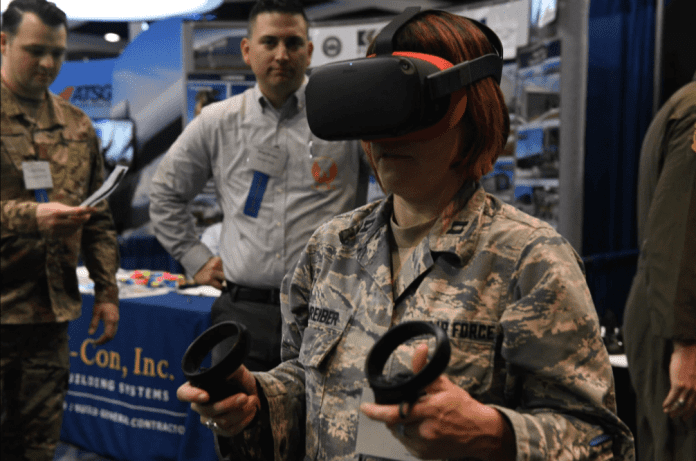A new $600 million round of funding by the US Department of Defense (DOD) is being made available for testing military-grade and industrial-grade 5G. The investment will go into smart logistics and industrial AR and VR systems, alongside combat-orientated aircraft and missile communications and training of the US military.
AT&T, Ericsson, Nokia, Federated Wireless, GE, KPMG, Deloitte – plus many others – have been appointed to prep the ground at five military bases in the US for these “dual use” 5G experiments. The DOD said the new military testbeds will give way to “the largest full-scale 5G tests for dual-use applications in the world”.
Federated Wireless, engaged in one of the smart warehousing projects, which also ropes in Cisco, Vectrus, and JMA, said the work had “implications… [for] all areas of government and the private sector”. Each installation will partner military services, 5G operators and vendors, industrial companies, and academic institutions.
Michael Kratsios, acting under secretary of defense for research and engineering, commented: “DOD is at the forefront of cutting edge 5G testing and experimentation, which will strengthen our nation’s war-fighting capabilities as well as US economic competitiveness in this critical field.
“Through these test sites, the department is leveraging its unique authorities to pursue bold innovation at a scale and scope unmatched anywhere else in the world. Today’s announcement [will explore]… the vast potential applications and dual-use opportunities that can be built upon next-generation networks.”
The test sites include: Hill Air Force Base, in Utah; Joint Base Lewis-McChord (JBLM), in Washington; Marine Corps Logistics Base (MCLB) in Albany, Georgia; Naval Base San Diego (NBSD), in California; and Nellis Air Force Base, in Las Vegas, Nevada. Each was selected on the grounds it provides “streamlined access to spectrum bands”, plus “mature” cellular and fibre infrastructure.
The essential focus is to deliver “leap-ahead capabilities for the US military,” said the DOD. “5G is a foundational enabler for all US defense modernization programs, and vital to US national and economic security,” it said. The funding builds on the department’s previously-announced 5G prototyping efforts. It represents the first tranche of awards on 5G experimentation and testing; new sites will be announced in due course, it said.
The smart logistics piece is focused on two sites: the NBSD facility in California and the MCLB venue in Georgia. The first of these is focused on digitising trans-shipment between shore facilities and naval units; the second is geared towards vehicular storage and maintenance.
AT&T has a nine-month deadline to deploy a dedicated cellular network at NBSD facility, based on commercially available 4G and 5G equipment in sub-6 GHz and millimeter wave bands. General Electric’s R&D unit, GE Research, will provide 5G applications for real-time asset tracking, warehouse modelling, and predictive analytics.
As well, Deloitte Consulting has been tapped for autonomous mobile robots, and drones and unmanned aircraft systems, alongside sundry biometrics and camera sensors, and AR/VR systems. Vectrus Mission Solutions, a provider of mission-critical IT for the US government, will provide inventory management, network security, and environmental sensing.
The group will seek to increase the “efficiency and fidelity” of naval logistic operations, including identification, recording, organisation, storage, retrieval, and transportation of materials and supplies. The project will be a proving ground for testing, refining, and validating 5G-based shipping and logistics technologies for the wider US market.
Meanwhile, Federated Wireless is to organise an open 5G solution for the MCLB vehicle storage testbed in Georgia. It has recruited Cisco, JMA Wireless, and Vectrus alongside. GE Research features again, offering the same asset tracking and predictive analytics platform.
KPMG joins, too, with a remit to create an integrated and automated process for monitoring “movement throughout the warehouse”. Engineering company Scientific Research Corporation (SRC) will provide an automated warehouse management and control platform into the bargain, for inventory tracking and access control. Again, the DOD said the Albany showcase will produce innovation for the wider economy.
Iyad Tarazi, chief executive at Federated Wireless, commented: “This deployment is the culmination of months of close collaboration among Federated Wireless, Cisco, Vectrus, JMA and the Department of Defense. It serves as a shining example of the innovative uses to which private 5G networks can be applied. We look forward to… extend the learnings and benefits of this deployment to other agencies, and into the private sector.”
The JBLM project, which focuses on AR and VR for training for mission planning and distributed training, will utilise a Samsung-based 5G testbed from GBL Systems, making use of mid-band spectrum, at two sites in Washington: eight square kilometres at the JBLM facility, itself, plus 40 square kilometres at the nearby Yakima Training Center.
AT&T is being brought in, again, to “develop a system to allow use of 5G connectivity with present training devices”. Oceus Networks and Booz-Allen Hamilton (BAH) will provide a ruggedised off-the-shelf 5G device and an AR/Vr prototype for combat-like training.
The other two sites, at the Nellis Air Force Base in Nevada and the Hill Air Force Base in Utah will develop testbeds for 5G to assist with “air, space, and cyberspace lethality”, and to introduce dynamic spectrum sharing between Air Force radars and 5G cellular services.
The Nevada project will employ a 5G network to disaggregate and mobilise existing command-and-control functions in combat scenarios. AT&T will provide the 5G setup in the 3.1-3.45 GHz band. The Utah spectrum-sharing testbed brings both Nokia and Ericsson into the scheme, with the former providing multi-antenna 5G systems and the latter handling machine learning for spectrum aggregation.
Others involved in Utah include General Dynamics Mission Systems, BAH, Key Bridge Wireless, and Shared Spectrum Company.

